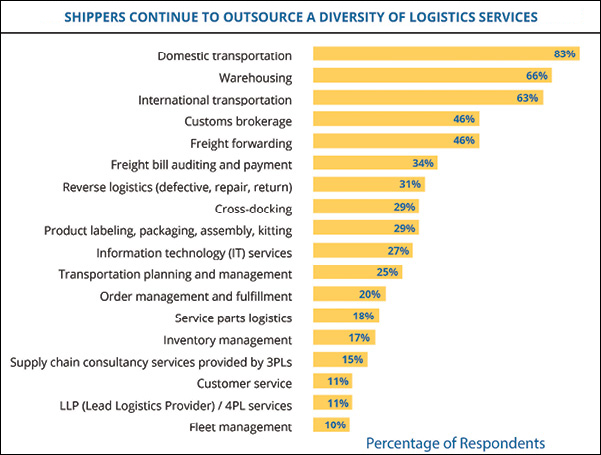The State Of Logistics Outsourcing

In an era where technology continues to migrate consumer spending habits online and away from brick-and-mortar stores, the 2019 Third-Party Logistics Study highlights how supply chains are also outsourcing, going digital and using science to keep pace.
Here are a few notable findings from the report, which was created and supported by Infosys Consulting, Penn State University, Penske Logistics, and Korn Ferry.
What are the top concerns and challenges in regards to supply chain decisions? This can be answered from two different perspectives: the companies that manufacture and distribute goods and services (referred to as shippers in the study) and third-party logistics (3PL) providers.
In order, the top nine concerns for shippers: infrastructure; workforce readiness; economic stability; freight/supply chain transparency; lack of strategic partners/suppliers in the region; regulations/tax structure; security/crime/corruption; executive-level talent; and border-crossing delays.
The list for 3PLs: workforce readiness; infrastructure; economic stability; freight/supply chain transparency; lack of strategic partners/suppliers in the region; executive-level talent; security/crime/corruption; regulation/tax structure; border-crossing delays.
Shifting consumer buying habits, which include a blend of in-person and online purchases of goods and services, require quicker responses than retail models of the past. Shippers recognize the need for agility, but 42 percent of survey respondents say they have not made the required changes to improve their agility over the past five years. Fifty-one percent of participants did say, however, that they are open to new ideas, creating more opportunities for 3PLs to introduce and implement innovations.
A key complaint among consumers who choose home or office delivery is that packages become lost more frequently. Within the supply chain’s last mile—defined as the final steps of package delivery to a person’s home or business—exists an undervalued concept known as the last yard. The majority of shippers (71 percent) and third-party firms (72 percent) recognize its influence on key retailer metrics such as consumer satisfaction and brand loyalty. Yet, only about one-third of survey takers agree that companies do enough to effectively manage last yard issues.
In any given week, consumers buy products online for home delivery or in-store pickup and also still visit physical stores to make a purchase or return. This shopping blend is known as the omni-channel. Retailers have been working hard to emphasize an always-on, always-open shopping experience that provides seamless interaction across all retail sales channels, and that is creating different demands on all supply chains. In the survey, 38 percent of shippers say they are inconsistent across the omni-channel and 36 percent note they have no capability in this area. To reverse this trend, supply chains are investing in integrated technologies that include: enterprise resource planning software (72 percent), warehouse management systems (56 percent), transportation management networks (38 percent), and supply chain visibility tools (34 percent).
Disruptions break even the strongest links across supply chains. When disruptions occur due to natural disasters, extreme weather or pandemics, supermarket shelves are missing key household items and products are out-of-stock online. The most common impacts, according to shipper respondents, are increased transportation and logistics costs (75 percent), transportation and logistics network disruptions (73 percent), and higher supplier costs (66 percent). The level of importance that companies and 3PLs place on mitigating these disruptions is greater than five years ago, with 23 percent of shippers and 22 percent of 3PLs scoring it significantly greater. The study notes that two major tools that companies and third-party logistics organizations can utilize to minimize disruptions are visibility tools (61 percent of shippers and 67 percent of 3PLs) and partnerships (72 percent and 64 percent, respectively). In the area of predictive analytics, 33 percent of 3PLs and 17 percent of companies are using these cutting-edge tools.
Data sharing between shippers and 3PLs becomes increasingly important. The key to a successful 3PL-shipper relationship is the foundation-building accomplished during the request for proposal (RFP) process. It ensures that both the short-term and long-term goals of both parties are clearly understood and reasonable expectations are set in the relationship. In the study, 36 percent of shippers and 35 percent of 3PLs agree that there are opportunities to improve how the sales team shares insight and data with account management.
